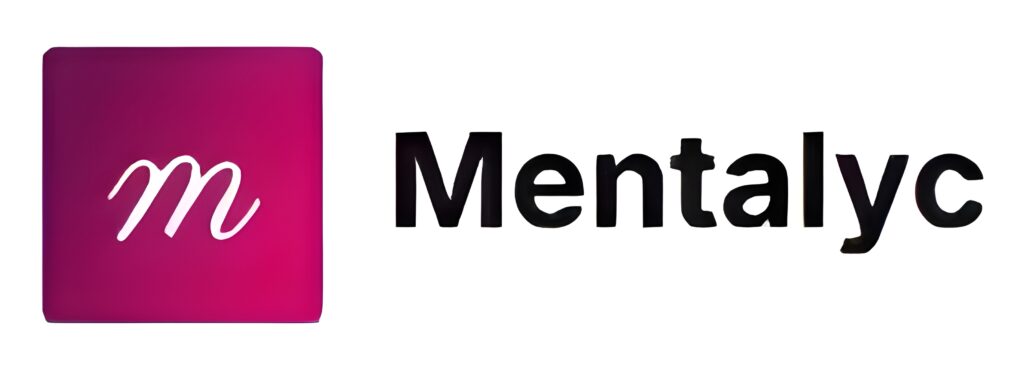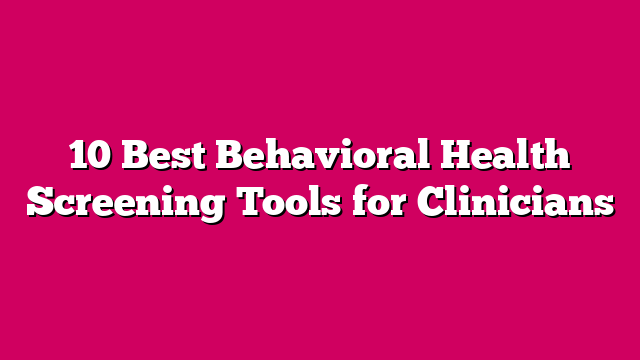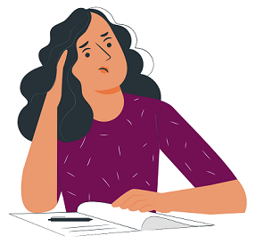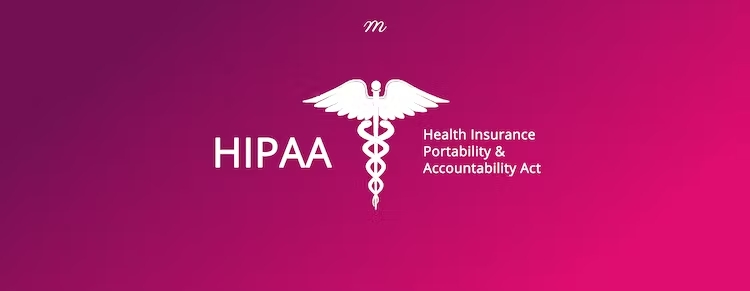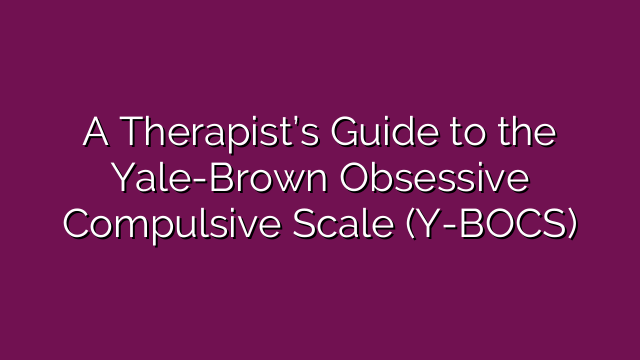Have your progress notes written for you automatically
Behavioral health screening tools offer a structured way to assess, monitor, and guide client treatment. These tools help identify mental health challenges early, track progress over time, and support clinical decision-making. Here’s a list of the top 10 behavioral health screening tools for therapists, complete with practical examples and tips for effective use.
1. PHQ-9 (Patient Health Questionnaire-9): The PHQ-9 is one of the most widely used tools for screening and monitoring depression severity in adults. It consists of nine items based on DSM-5 criteria for major depressive disorder, making it both diagnostic and actionable (Kroenke et. al. 2001).
Example: Marco reports feeling low energy and experiencing poor sleep for weeks. He is often awake most of the night and has difficulty getting out of bed each morning. He has been late to work several times and faces losing his job. His employer referred him to a counselor, who administered the PHQ-9, and it revealed a score of 17 (indicating moderate to severe depression). Marco’s counselor recommended Cognitive Behavioral Therapy (CBT) and a psychiatric evaluation for medication.
Tip: Use the PHQ-9 at intake and repeat every 4–6 weeks to track symptom changes and guide treatment adjustments.
2. GAD-7 (Generalized Anxiety Disorder-7). The GAD-7 is a quick, seven-item measure designed to evaluate anxiety severity in teens and adults. It’s versatile enough to detect generalized anxiety as well as other anxiety disorders, such as social anxiety or panic disorder (Spitzer et al. 2006).
Example: Marta, a 19-year-old college student, struggles with test anxiety. She saw a counselor on campus and scored a 14 on the GAD-7, indicating moderate anxiety. The counselor used this information to focus therapy on relaxation techniques and time management strategies.
Tip: Pair the GAD-7 with open-ended questions about anxiety triggers to create a comprehensive treatment plan.
3. ACE Questionnaire (Adverse Childhood Experiences). The ACE questionnaire for teens and adults explores ten categories of adverse childhood experiences, such as abuse, neglect, and household dysfunction (Felitti et al., 1998). A higher score correlates with an increased risk of mental health challenges and chronic illnesses.
Example: Jordan has a history of substance use and has an ACE score of 7. His therapist incorporates trauma-informed care and EMDR therapy into the treatment plan to address underlying issues.
Tip: Approach high ACE scores with sensitivity, emphasizing resilience and protective factors rather than focusing solely on risk.
4. AUDIT (Alcohol Use Disorders Identification Test). The AUDIT is a 10-question tool that evaluates alcohol consumption, dependence symptoms, and related problems in adults (Babor et al., 1989). It’s ideal for primary care and behavioral health settings.
Example: Maya casually mentions drinking nightly to her therapist. She’s been in therapy for two months following the end of a romantic relationship. The therapist administered the AUDIT, and Maya’s score was 12, indicating hazardous drinking. The therapist used Motivational Interviewing (MI) to explore Maya’s readiness for change and developed a harm-reduction plan.
Tip: Normalize the use of the AUDIT by explaining that alcohol use is a routine part of mental health assessments, reducing client defensiveness.
5. DASS-21 (Depression, Anxiety, and Stress Scale – 21 Items). The DASS-21 provides a comprehensive view of adult clients’ emotional states by measuring three dimensions—depression, anxiety, and stress (Lovibond & Lovibond, 1995). It helps identify comorbid conditions.
Example: Joseph complains of irritability and concentration problems during his initial therapy session. The DASS-21 reveals high scores in stress and moderate scores in depression. The therapist uses these results to focus on stress management techniques and coping strategies so Joseph can better manage his high-stress corporate job.
Tip: Use the DASS-21 for clients presenting with overlapping symptoms to pinpoint the most pressing areas for intervention.
6. Vanderbilt ADHD Diagnostic Rating Scale. This scale is a parent- and teacher-completed questionnaire that screens for ADHD symptoms and co-occurring issues in children ages 6-12, such as conduct problems or anxiety (Wolraich et al., 2003).
Example: 9-year-old Christopher struggles academically and has difficulty sitting still and playing well with other children. He scores high in hyperactivity/impulsivity but low in inattention. The school counselor works with the family and teacher to implement behavioral strategies and accommodations.
7. Columbia-Suicide Severity Rating Scale (C-SSRS). The C-SSRS is a short, structured interview tool designed to identify suicide risk factors in all ages, such as ideation, plans, and prior attempts (Posner et al., 2011). Its simplicity and effectiveness make it a go-to resource in crisis situations.
Tip: Collect responses from both parents and teachers to get a fuller picture of a child’s behavior across settings.
Example: Gloria is a 16-year-old high school student who reports feeling hopeless. The C-SSRS reveals passive suicidal ideation but no immediate plan, prompting her therapist to create a safety plan and increase session frequency.
Tip: Use the C-SSRS routinely with clients at higher risk for suicide, such as those with mood disorders or recent trauma.
8. SDQ (Strengths and Difficulties Questionnaire). The SDQ evaluates emotional symptoms, conduct problems, hyperactivity, peer relationships, and pro-social behavior in children and teens aged 4-17. It’s a quick and accessible way to screen for potential issues in school-aged children.
Example: A teacher reports 11-year-old Alberto’s recent aggressive outbursts. The SDQ highlights difficulties in peer relationships and pro-social behavior, guiding Alberto’s therapist to focus on social skills training.
Tip: Pair the SDQ with interventions emphasizing the child’s strengths, reinforcing resilience while addressing challenges.
9. PCL-5 (Posttraumatic Stress Disorder Checklist for DSM-5). The PCL-5 is a self-report measure for adults that assesses PTSD symptoms based on DSM-5 criteria (Weathers et al., 2013). It’s ideal for tracking symptom severity and evaluating treatment outcomes.
Example: William is a 39-year-old veteran reporting nightmares and flashbacks. He completes the PCL-5 and scores 44, suggesting probable PTSD. William’s therapist begins trauma-focused therapy (Prolonged Exposure and EMDR).
Tip: Use the PCL-5 periodically to measure progress during trauma-focused interventions.
10. Yale-Brown Obsessive Compulsive Scale (Y-BOCS). The Y-BOCS is considered the gold standard for measuring obsessive-compulsive symptoms in adults and teens (Goodman, et al. 1989). It evaluates the severity and interference of obsessions and compulsions.
Example: Hunter is a 22-year-old mechanic with compulsive handwashing and counting behavior who completes the Y-BOCS and scores 26, indicating severe OCD. Hunter’s therapist uses Exposure and Response Prevention (ERP) therapy, monitoring symptom changes with repeat administrations of the Y-BOCS.
Tip: Use the Y-BOCS to set specific treatment goals, such as reducing the time spent on compulsive behaviors.
How to Choose the Right Assessment Tools
Selecting the appropriate assessment and screening tools is a critical step in providing effective, evidence-based treatment. The right tool aligns with clients’ needs and integrates seamlessly into a therapist’s workflow. Here are key considerations and strategies:
1. Understanding the Client Population. The first step in selecting a tool is knowing clients’ demographics and presenting issues. Using the most appropriate tools ensures that assessments are relevant, accurate, and culturally appropriate. Consider the following:
- Client Age: Some tools are designed for specific age groups. For example, the Vanderbilt Assessment Scale effectively evaluates ADHD symptoms in pediatric clients.
- Presenting Issues: If a client presents with trauma-related concerns, the PCL-5 provides a targeted approach for PTSD symptoms. For clients with mood or anxiety concerns, the DASS-21 offers a broad-spectrum view.
2. Consider Practicality. In busy practices, time and ease of use are crucial. Select tools that are easy to administer and interpret, ensuring they don’t overwhelm workflow or burden clients.
- Administration Time: Tools like the PHQ-9 are quick to administer, taking only a few minutes, making them ideal for routine screenings.
- Comprehensive assessments like the MMPI-2 are better suited for in-depth evaluations when time permits.
- Ease of Interpretation: Look for tools with clear scoring systems and actionable results. Like many digital platforms, tools with automated scoring options or built-in interpretive guidance streamline the process.
3. Treatment Plan Integration. Assessment tools are most valuable when their results directly inform treatment plans. Use screening outcomes to identify key focus areas, set measurable goals, and track progress over time.
- Guiding Interventions: If a client’s GAD-7 score indicates severe anxiety, it can guide the decision to prioritize anxiety-focused interventions, such as CBT techniques or relaxation training.
- Measuring Progress: Re-administering tools at regular intervals allows therapists to measure changes and evaluate the effectiveness of interventions. For instance, tracking a client’s progress with the PHQ-9 highlights improvements or areas requiring further attention.
4. Combine Tools. No single tool captures the full complexity of a client’s experiences. Combining tools provides a more comprehensive understanding of their mental health.
- Broad vs. Specific Assessments: Use tools like the DASS-21 for an overview of depression, anxiety, and stress levels, then follow up with a focused tool like the PCL-5 for trauma-specific concerns.
- Layering Assessments: Pairing screening tools with functional or behavioral assessments can offer additional insights. For example, combining the Connor-Davidson Resilience Scale with the PHQ-9 might highlight a client’s strengths alongside their challenges.
5. Factor in Cultural and Linguistic Considerations. Ensure the tools are validated for diverse populations and available in languages matching clients’ needs. Using culturally sensitive tools avoids bias and improves the accuracy of results.
6. Leverage Technology When Possible. Digital tools and platforms enhance clinical practice by automating scoring, tracking visual progress, and integrating assessments into electronic health records (EHR). This saves time and ensures that results are easily accessible for ongoing treatment planning.
Best Practices for Using Behavioral Health Screening Tools
- Normalize the Process: Explain that screening tools are part of standard practice to reduce client apprehension.
- Discuss Results: Share the results with clients to enhance collaboration and transparency in treatment planning.
- Use Technology: Many tools are available digitally, streamlining administration and scoring. Platforms like TherapyNotes or SimplePractice offer integrated options.
- Reassess Regularly: Screening tools are not one-and-done! Use them throughout treatment to track progress and adjust interventions.
Conclusion
Behavioral health screening tools are indispensable for therapists because they offer a structured, evidence-based way to assess and address mental health concerns. Therapists provide more targeted and effective treatment by incorporating tools like the PHQ-9, GAD-7, and PCL-5 into their practice. Let these tools guide clinical decisions, enhance client outcomes, and elevate clinical practice to new levels of professionalism and effectiveness.
References
Babor, T. F., de la Fuente, J. R., Saunders, J., & Grant, M. (1989). The Alcohol Use Disorders Identification Test: Guidelines for use in primary health care. World Health Organization.
Felitti, V. J., Anda, R. F., et al. (1998). Relationship of childhood abuse and household dysfunction to many of the leading causes of death in adults: The Adverse Childhood Experiences (ACE) Study. American Journal of Preventive Medicine, 14(4), 245–258.
Goodman, W. K., et al. (1989). The Yale-Brown Obsessive Compulsive Scale: Development, use, and reliability. Archives of General Psychiatry, 46(11), 1006–1011.
Kroenke, K., Spitzer, R. L., & Williams, J. B. W. (2001). The PHQ-9: Validity of a brief depression severity measure. Journal of General Internal Medicine, 16(9), 606–613.
Lovibond, P. F., & Lovibond, S. H. (1995). The structure of negative emotional states: Comparison of the Depression Anxiety Stress Scales (DASS) with the Beck Depression and Anxiety Inventories. Behaviour Research and Therapy, 33(3), 335–343.
Posner, K., et al. (2011). The Columbia-Suicide Severity Rating Scale: Initial validity and internal consistency findings from three multisite studies with adolescents and adults. American Journal of Psychiatry, 168(12), 1266–1277.
Spitzer, R. L., Kroenke, K., Williams, J. B. W., & Löwe, B. (2006). A brief measure for assessing generalized anxiety disorder: The GAD-7. Archives of Internal Medicine, 166(10), 1092–1097.
Weathers, F. W., et al. (2013). The PTSD Checklist for DSM-5 (PCL-5). National Center for PTSD. Retrieved from https://www.ptsd.va.gov/professional/assessment/adult-sr/ptsd-checklist.asp
Wolraich, M. L., Lambert, E. W., et al. (2003). Psychometric properties of the Vanderbilt ADHD Diagnostic Parent Rating Scale in a referred population. Journal of Pediatric Psychology, 28(8), 559–568.
